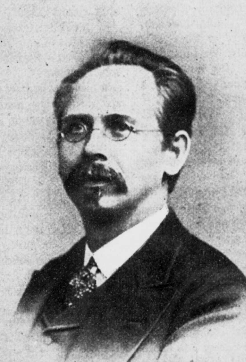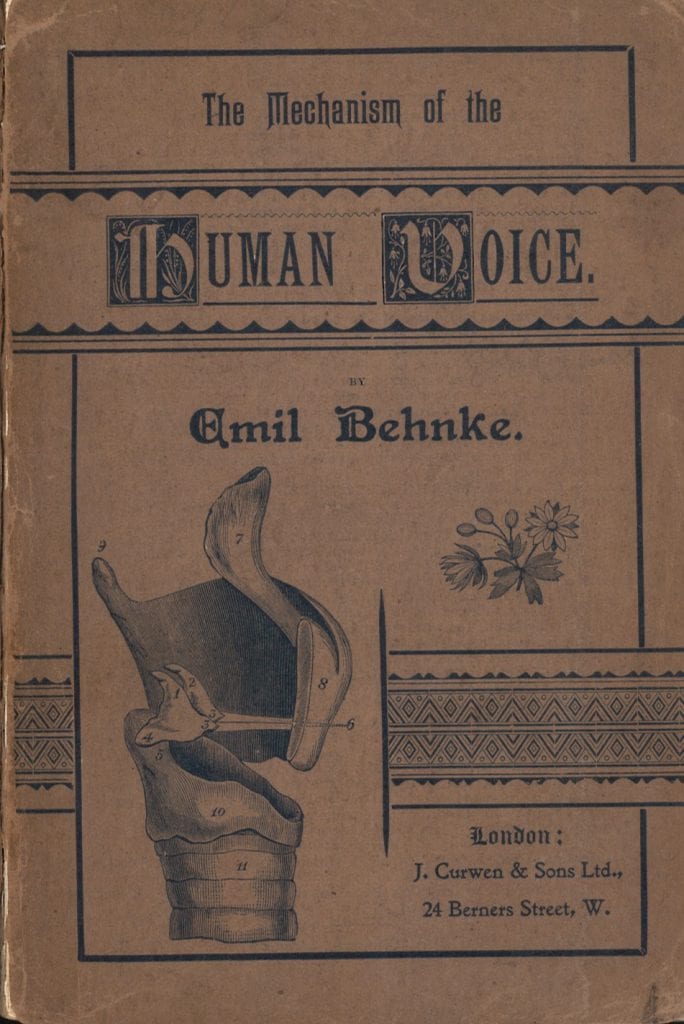Voice trainer, Emil Behnke, “as accurate as Huxley and as fascinating as Faraday”
By H Dominic W Stiles, on 17 February 2017
 Emil Behnke (1836-1892) was born in Stettin, the son of a merchant, but became a naturalized British subject. From around 1860 he began to study the voice, and “the physiological aspects of singing and speaking” (People, Places, and Things). He sang baritone with an opera company, before moving to England in 1865 (Musical Herald, 1892). He was one of the foremost voice trainers of the mid to late 19th century, in fact his obituary in The Times practically attributes the foundation of a new discipline to him:
Emil Behnke (1836-1892) was born in Stettin, the son of a merchant, but became a naturalized British subject. From around 1860 he began to study the voice, and “the physiological aspects of singing and speaking” (People, Places, and Things). He sang baritone with an opera company, before moving to England in 1865 (Musical Herald, 1892). He was one of the foremost voice trainers of the mid to late 19th century, in fact his obituary in The Times practically attributes the foundation of a new discipline to him:
At the age of 30 he began to lecture on “the Mechanism of the voice” under the auspices of such physiological experts as Professors Sharpey, Burdon Sanderson, M’Kendrick, and Struthers, and speedily had engagements at the foremost musical and scientific societies of the country. So ingenious were his illustrative models and so successful was he in the application of scientific principles to the practical work of the teaching of singing, and more particularly to the restoration of voices impaired by false training, that he may be said to have established an entirely new profession, and he was universally accepted as a leading authority on all matters relating to the voice. He was consulted by many eminent teachers of singing and worked in co-operation with leading medical specialists.
Behnke was co-author with Lennox Browne of The Child’s Voice (1885), and Voice Song and Speech (1883). Lennox Browne was a founder of the Royal National Throat Nose and Ear Hospital, our present home, and a leading ENT surgeon. Interestingly, The Child’s Voice, was dedicated to Sir John Stainer the musician and composer, who was of course the brother of our old friend, the Rev. William Stainer, teacher of the Deaf. I wonder if there were connections between William Stainer and Lennox Browne or Behnke.
According to Rachel Holmes, in her biography of Eleanor Marx, Eleanor Marx: a life (2014, p.158), she says that along with John Hullah, Behnke taught the theatrical couple Hermann and Jane Elizabeth Vezin. As a teacher and lecturer he was, according to People, Places, and Things, “as accurate as Huxley and as fascinating as Faraday.” He had a deep knowledge of vocal physiology and anatomy, and the same article says that he was invited to lecture at UCL by Burdon Sanderson and Sharpey, and that “Professor Foster put his theatre at Behnke’s disposal.”
Behnke held ‘concerts’ or as he preferred to say, ‘open rehearsals’ using the tonic sol-fa method of singing’ that was invented in Norwich by Sarah Glover and pioneered by John Curwen, who had been a student at UCL, and whose son, music publisher John Spencer Curwen, wrote Behnke’s obituary. The Curwen’s knew Behnke from tonic sol-fa conventions.
One former school pupil of Behnke’s said, “he saved me from being an utter cad” (The Musical Herald, Nov 1, 1892).
There is a charming reminiscence of him in The Musical Herald (1898) by ‘E.D.’:
I was a little girl at a boarding-house in Weymouth when I became the pupil of Herr Behnke. He was not then the noted voice specialist that he afterwards became, but a dark-haired young man fresh from Germany, who had been engaged to give drawing, French, and piano lessons at Miss S—–‘s school. Although he had been in England, I believe, only a few weeks, his English was well-nigh perfect.
[…]
“Never mind the notes,” he would say, when I was over-anxious lest my fingers should drop on the wrong keys; “Never mind the notes, keep time!“
John S. Curwen, who clearly held him in very high regard, said, “He stood halfway between the doctor and the singing master” (p.293). He died in Ostend on a holiday, when he was trying to recuperate from the illness that dogged his last years. His friend Lennox Browne even crossed over to see if there was anything he could do to help, but Behnke died on the 17th of September, 1892, at the age of only 56 (Curwen, p.291).
His wife and his daughter Kate Emil-Behnke continued his teaching legacy, and both wrote books and updated his books. There is much more interesting to say about the three of them, beyond the scope of this item.
 Curwen, J Spencer. The Musical Herald; London 535, (Oct 1, 1892): 291-294
Curwen, J Spencer. The Musical Herald; London 535, (Oct 1, 1892): 291-294
THE LATE EMIL BEHNKE.The Musical Herald; London 536 (Nov 1, 1892): 351-351.
Some Reminiscences of Emil Behnke. E D. The Musical Herald; London 598(Jan 1, 1898): 22-22.
People, Places, and Things. Hearth and Home (London, England), Thursday, October 13, 1892; pg. 716; Issue 74
The Times 19th of September 1892, p. 9
1871 Census (Curwen family) – Class: RG10; Piece: 1629; Folio: 11; Page: 13; GSU roll: 829938
[Picture from the obituary in The Musical Herald.]
 Close
Close

